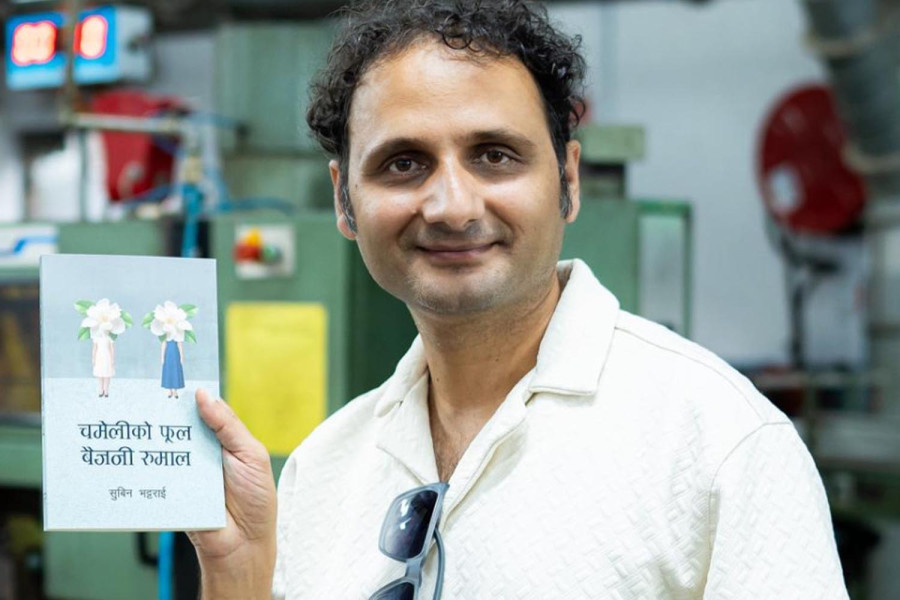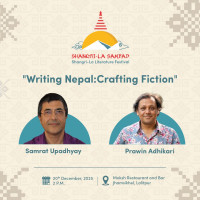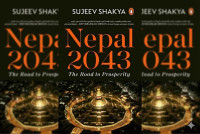Culture & Lifestyle
Nepal’s creative scene can be transformed following the Gen Z movement: Subin Bhattarai
The writer discusses his upcoming book, ‘Chameliko Phool Baijani Rumal’, and why there can never be another ‘Summer Love’.
Anish Ghimire
After three years, Nepal’s beloved writer Subin Bhattarai has returned with a new book. A big believer in experimentation and trying new things, the writer says his latest book, a story collection, ‘Chameliko Phool Baijani Rumal’, has a little bit for everyone.
Since the book, which launches on Friday, has seven stories, Bhattarai calls it a “Saptarangi Samyog” (a meeting point of seven different colours), emphasising its variety. In this chat with the Post’s Anish Ghimire, Bhattarai discusses the title of his seventh book, the recent Gen Z movement, and how his writing has evolved since ‘Summer Love’.
What inspired ‘Chameliko Phool Baijani Rumal’? And what is the meaning of such a poetic title?
Many novel ideas come to mind, but not each one can be developed into a full-length book. So, I decided to write longer stories and compile them. This collection includes seven stories—some stretching up to 40 pages. The format is somewhat similar to Haruki Murakami’s ‘Men Without Women’. I intended to create stories that don’t feel like novels, yet aren’t as brief or superficial as short stories—I wanted them to have real depth.
At the same time, I didn’t want to stretch or overcomplicate the plots and characters just for the sake of making them novels. I believe each story stands on its own. In fact, if any of them were adapted into films, they would work perfectly, because when novels are turned into movies, so much often gets lost in translation.
As for the title, it comes from one of the stories in the book. That story is particularly intense and thematically dense. Both the title and the cover image capture its essence beautifully.
You started your career with a story collection. After writing so many novels, why have you gone back to writing stories again?
I’m a big believer in experimenting and trying something new. After writing several novels on different themes, I didn’t want to create yet another thick novel. I felt the need to write something that sits in between—stories that are neither short nor long. I wanted to craft medium-length stories that go beyond a few pages and offer character depth.
I’ve also been inspired by Fyodor Dostoevsky’s ‘White Nights’, a short story that continues to resonate with readers even today. Similarly, Haruki Murakami writes remarkably long stories that could be considered novellas.
I’m also a firm believer that quality beats quantity. So, this time, I focused on crafting stories with depth and quality instead of focusing on length.
How is this book different from your previous works, like ‘Summer Love’ or ‘Saya’?
‘Summer Love’ and ‘Saya’ are painted in the same shades, but this one is a rainbow—a saptarangi samyog, a meeting point of seven different colours. That’s the best way I can describe the difference.
‘Chameliko Phool Baijani Rumal’ is coming out during intense social unrest. How do events like the Gen Z movement influence your writing?
The political state of a nation affects every sector. The country is changing, and I believe this shift will also steer art and culture in a new direction. There’s now room for update and upgrade in this field.
After the Maoist unrest, many literary voices emerged. Similarly, writers like BP Koirala and Govinda Bahadur Malla ‘Gothale’ often placed the 1950 revolution at the heart of their stories. As society moves forward, writers naturally follow that movement.
I’m sure many writers will soon start writing about this uprising—and they should. I feel that news media can’t capture the psychology of the people affected by the Gen Z movement. We’ve seen many articles and updates lately, but most readers are after quick, clickbait news. Those stories get shared widely, but they lack depth.
That’s where literature steps in. For instance, if a boy sets a house on fire, the news might report what happened—but literature asks ‘why’. What drove him to it? Where did he come from? What was going through his mind? These are the layers only literature can explore. I really want to write about this in the coming days. I haven’t decided how yet, but I know I will.
Many Nepali readers grew up with ‘Summer Love’. Do you feel pressure to meet those expectations with every new release?
I stopped feeling that pressure. I wrote that book in the past, and the past is gone. I should not and cannot write another ‘Summer Love’. After that novel, people demanded a sequel, so I wrote ‘Saya’. Again, they wanted another love story, so I wrote ‘Monsoon’—somewhat similar to ‘Summer Love’.
Even though ‘Monsoon’ was commercially successful, I am not satisfied with how it turned out. Being honest with you, I am also not happy with ‘Saya’. Looking back, I feel like I wrote those books under the pressure of ‘Summer Love’—and they didn’t turn out so great.
In contrast, when I wrote without the pressure of ‘Summer Love’, as I did with ‘Priya Sufi’ and ‘Ijoriya,’ the books turned out very well.
How long did it take you to write this new book, and what was the writing process like this time?
This book came together over the past year. Several of my friends read the early drafts and offered helpful feedback, which I built upon. Whenever an idea struck me, I’d sit down and write for two days straight—I used to go ‘underground’ and wouldn’t stop until a draft was ready. Whenever someone asks me for a piece to publish, I usually say I need a month. But honestly, most of that time goes into thinking and planning. The actual writing happens in just two days. A lot of the effort lies in designing the story in my head first.
The back-and-forth of editing and reworking the book can be exhausting at times, but I genuinely enjoy the process.
I’m quite optimistic about this book, though it’s hard to say anything definite right now. The country is going through a difficult time, and people might not be in the mood for literature. Some readers may expect a novel and feel disappointed, but I’ve always believed that in literature, quality outweighs quantity, and that’s what this book carries.




 8.12°C Kathmandu
8.12°C Kathmandu















